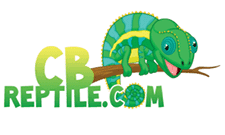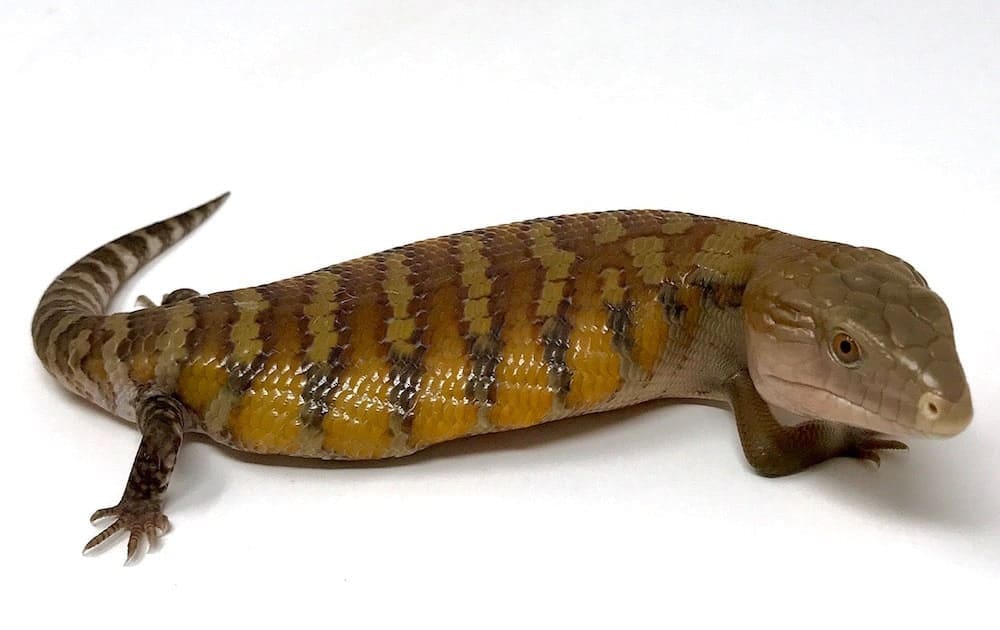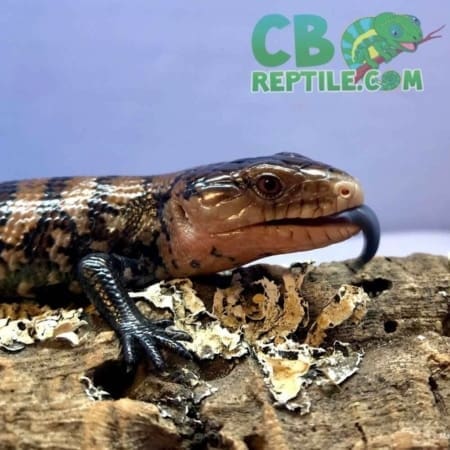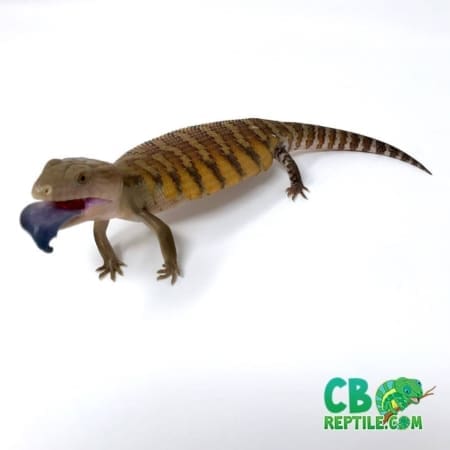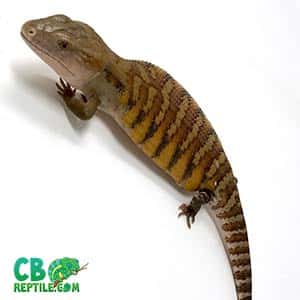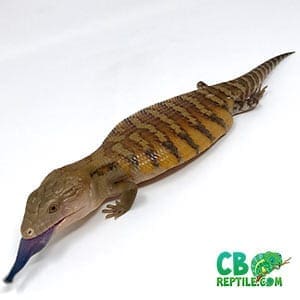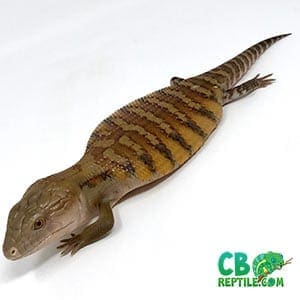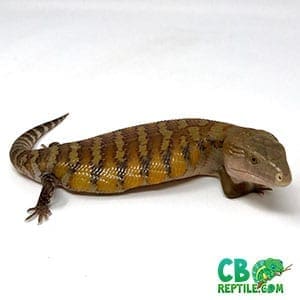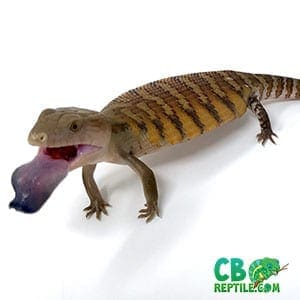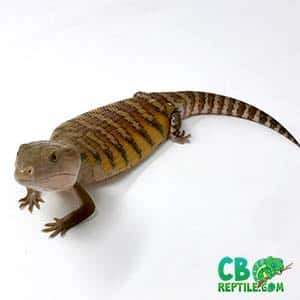Blue tongue skink care sheet
Blue tongue skinks for sale are forest floor dwelling lizards with large, smooth, flat scales; a wide head and a bright blue tongue. A great pet lizard for any reptile enthusiast the blue tongue is often even referred to as affectionate!
Be sure to spend some time reviewing all of our blue tongue skink care sheets provided by our staff biologist here at CB Reptile! Learn more information about blue tongue skink care include:
- Blue tongue skink care sheet
- Blue tongue skink diet
- Northern blue tongue skink size
- blue tongue skink lifespan
- northern blue tongue skink
- blue tongue skink breeders
- blue tongue skink temperature
- baby blue tongue skink
- blue tongue skink UVB Lighting
- baby blue tongue skink habitat
- red eyed crocodile skink for sale
- red eyed crocodile skink care
- blue tongue skink for sale
- halmahera blue tongue skink
- blue tongue skink humidity
- blue tongue skink substrate
Long lived repltiles, the blue tongue skink can live for longer than 12 years. They are omnivores and will eat a very wide range of foods including plant matter and live insects. In the wild, they will also eat carrion and any mammals, reptiles, birds or amphibians they can find, though snails are their main food source and should be included in captivity.
Before acquiring a baby blue tongue skink (BTS) you must be sure that you are able to provide the correct care and associated costs for its whole life. There are many species and subspecies including beautiful Northern blue tongue skinks for sale available so you must be sure to have correctly identified the species you keep. Some are farmed in their native range but you should only obtain a skink bred in captivity in this country.
Blue tongue skink Temperature
Like most reptiles the blue tongue skink needs both cool and hot ends of its’ habitat. Blue tongue skinks, like all reptiles are ectothermic. What this means, is they use their environment to warm up and cool down, so you need to create a ‘thermogradient’. This means positioning the heat source at one end of the vivarium, leaving the other end cooler, so the reptile can move around to regulate its body temperature. Create a ‘basking spot, or hot spot’ for your skink. The basking spot should be the warmest spot in the entire habitat. Use a Mercury vapor lamp for your heat lamp or ceramic heat emitter always pointing towards the substrate. Typically, we would mount heat lamps around 18″ above the substrate.
Use a reptile thermostat to regulate your blue tongue skink habitat temperature
Heat lamps must be guarded to prevent them getting too hot and causing burns. We recommend that a reptile thermostat be used with all heat and basking lamps. A reptile thermostat is used to measure the temperature and prevent the habitat from getting too hot. Adjust the thermostat temperature and check with a digital thermometer that the basking zone is between 90-95 degrees , up to 98 degrees for younger skinks. The cool end should measure 75-80 degrees. The temperature should only drop 10 degrees or so in the evenings, so you may need to use a thermostat with your heating device or lamp.
Blue tongue skink size
A rather large and docile species of pet skink for sale, a blue tongue skink will grow to around 24-27 inches in length. Did you know that the Northern blue tongue skink is the largest of all subspecies of blue tongue skink for sale? Large and in charge but calm and laid back is the typical adult Northern Blue Tongue skink for sale.
Blue tongue skink for sale Humidity
Humidity is important and often controlled by a fogger, spraying your substrate, etc. For this reason, we recommend that a hygrometer is used. Using a hydrometer, measure the humidity at the cool end, which should normally be around 40 to 45% the average Blue tongue. Australian species, on the other hand, such as Northern Blue tongue skink, enjoy drier environments. Because of this, always be sure to check your species’ humidity requirements. Options for boosting humidity include spraying the enclosure substrate and walls with clean water. Also, taller glass habitats will require ventilation as well.
Blue tongue skink for sale – UV Light
Whether they need UVB or not, most reptiles use natural daylight to set their day and night patterns. Blue tongue skinks are no different! In nature, the BTS has thick skin that offers it some protection from the UVB. For this reason, we need to provide an adequate source of UVA and UVB light. It is beleived that blue-tongue skinks can see both UVA and UVB that helps with their color vision as well as vitamin d absorption. The most important part is the UVb, which allows the lizard to make vitamin D3. Using the right type of blue tongue skink lights are very important.
Why does a blue tongue skink require UVB?
UVB light allows the BTS to store and use calcium, an essential mineral as well as vitamin d3. A UVb reptile lamp must be used inside the habitat alongside the basking lamp as they give off different spectrums. Often basking lamps, while providing UVa, do not provide as much UVb, required for the skink. In a vivarium or blue tongue skink habitat of 15″ high, a 5 or 6% UVb tube should be used. We recommend a T5 high output lamp, around half the length of the habitat should be used.
UVB lamps should be attached to the roof of the vivarium with the reflector facing the substrate of course. Both light and shade should to be provided at all times, to allow the animal to self-regulate, so make sure the tube is in the hot side. For this reason, try to will leave the cooler end of the blue tongue skink habitat more shaded. UVb output decreases over time, so the UV lamp should be changed usuallt every 6 months, or according to the instructions. Higher quality Blue tongue skink uvb lamp brands like arcadia last longer.
Blue tongue skink light timer
Use a timer to regular your day and night cycles for your skink. Turn off all lights at night to simulate night-time; usually with 10-12 hours of light and 12-14 hours od dark to keep your skink healthy. We use a simple but efficient light timer to control all of our habitat lighting.
Blue tongue skink Diet
Water is essential to the health and well being of the blue-tongue skink. A large, shallow dish should be provided at all times with clean, fresh water placed in the cool end. Some skinks will drink standing water but if not, you should lightly spray the vivarium with water every day or every other day, depending on the humidity, to allow the skink to collect droplets of water to drink as they do in the wild. Replace the water every day and if your skink goes to the toilet in the bowl.
Feeding your baby Blue tongue skink
It is essential to provide a varied diet of appropriatelysized live insects, such as crickets, ‘calciworms’, ‘waxmoth larvae’, fruit beetle grubs, dubia cockroaches, silkworms and locusts every day. Remove uneaten crickets or locusts as they can bite the skink. You need to research the safe plants and vegetables to feed and provide these at all times. Avoid feeding too much spinach as this prevents calcium absorption. Also avoid too much kale as this can affect hormone production. Remove uneaten green food every day and replace with fresh. It is vital that the feeder insects are ‘gut-loaded’ with safe vegetables and hydrated well for their own welfare and so that the nutrients are passed onto the skink.
Blue Tongue Skink Substrate
Always use the correct substrate for your new baby blue tongue skink habitat. Substrate is what we call the bedding or flooring covering the bottom of your blue tongue skink habitat. Since blue tongue skinks by nature like to burrow, always provide at least 4″ of substrate depth. This will encourage their natural behaviors they have in the wild. By providing this you are starting out with a habitat that supports the real activities of a wild blue tongue skink.
Substrate also has other important factors that contribute to having the right blue tongue skink habitat. Here at CB Reptile, we use forest floor cypres mulch, that we mix with some organic potting mix, as well as some coco coir. You can use a mixture of coco bark and coconut coir and could add some sand for the Australian species (the northern blue tongue skink the largest of the family hails from Australia.
Just think about what you are trying to acheive and your substrate selection is easy.
Common sense is needed when setting up your habitat. For example, always use reptile-safe sand such as clean children’s play sand rather than builders’ sand, which has sharp edges. Be careful not use unnatural or indigestible substrates such as ‘calci-sand’, small gravel, fish tank gravel, beach chips, corn cob granules or crushed walnut shells or pellets like alpha.
They are dangerous because they can clog the digestive tract and cause a blockage in a condition called ‘impaction’.
Keeping multiple pet skinks for sale together
It is advised that you keep skinks separately due to their territorial nature of the reptile. When housed together, they can bite each other, get injured or even have a fatal battle. Handling Blue-tongue skinks can tolerate human interaction and handling after settling in and is recommended from the day you receive them. If scared, a BTS does have a fairly strong bite and need time to get used to you. Never grab them from above as this can cause stress. Like most lizards, the blue tongued skink should be gently scooped up with both hands so its’ legs and weight are supported.
If your skink backs away from you or opens its mouth to display its tongue, it is better to wait for another time. When you see this, your skink is scared and you should give it some time and come back later. Like most reptiles, Skinks should not be removed from the habitat for long periods of time, so that their core temperature does not drop. We recommend no more than 20 minute intervals out of the habitat to handle your skink. Also, Blue-tongues have nails so be careful that they do not get them stuck in your carpet or clothes.
